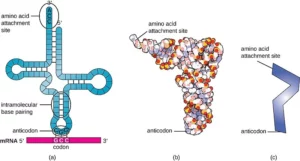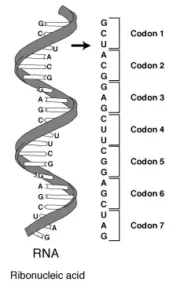The group of nucleotides known as anticodons are essential for the production of proteins from genes. Let us learn about this in detail.
An anticodon is a trinucleotide sequence that is complementary to a matching codon in a messenger RNA (mRNA) sequence and is found at one end of a transfer RNA (tRNA) molecule.
During translation, complementary bases attach to the bases on mRNA on one end (anticodon), and an amino acid attaches to the other end.
Let us discuss some of the examples of tRNA anticodon and anticodon sequence in this article in details.
tRNA anticodon example
A tRNA anticodon is a 3-base sequence that is complementary to one or more mRNA codons’ 3-base sequences. Let us see the working principle of anticodons with suitable examples.
- There are 64 potential combinations of anticodons, there are only 61 anticodons that code for protein synthesis.The three extra anticodons are involved in stopping the production of proteins.
- Mature mRNAs have an open reading frame that is translated during the translation process. As every codon is read, e.g. AUG (= start codon), the charged tRNA (charged means it has its amino acid bound to it, and its correct amino acid is called its cognate amino acid) binds with its anticodon UAC to the mRNA, which is now both (charged tRNA + mRNA) located inside a ribosomal complex.
- Before protein synthesis, amino acids are transported by tRNA molecules. For example,The tRNA molecule’s “3 end acceptor end” is where the amino acids are connected. The anticodon loop, which originates at the base of the molecule, is one such loop.
- tRNAs need an anticodon to provide the correct amino acid to the corresponding codon, which is found on the mRNA during translation.
- A codon’s three bases on the mRNA are represented by the three nucleotides that make up an anticodon. Each tRNA contains a distinct anticodon triplet sequence that can form 3 complementary base pairs to one or more codons for an amino acid.
- That necessarily includes the two-stop anticodons that are also transcribed into the mRNA, but the ribosome falls off the mRNA at such an anticodon since there is no tRNA carrying an amino acid corresponding to the anticodon stops.
The following list of potential anticodons is based on the genetic code, which contains codons that represent amino acids.
| AMINO ACIDS | ANTICODON EXAMPLE |
| Phenylalanine | AAA and AAG |
| Leucine | AAU, AAC, GAA, GAG, GAU, GAC |
| Isoleucine | UAA, UAG, UAU |
| Methionine | UAC |
| Valine | CAA, CAG, CAU, CAC |
| Serine | AGA, AGG, AGU, AGC, UCA, UCG |
| Proline | GGA, GGG, GGU, GGC |
| Threonine | UGA, UGG, UGU, UGC |
| Alanine | CGA, CGG, CGU, CGC |
| Tyrosine | AUA, AUG |
| Histidine | GUA, GUG |
| Glutamine | GUU, GUC |
| Asparagine | UUA, UUG |
| Lysine | UUU,UUC |
| Aspartic acid | CUA, CUG |
| Glutamine acid | CUU, CUC |
| Cysteine | ACA, ACG |
| Tryptophan | AGU, ACC |
| Arginine | GCA, GCG, GCU, GCC, UCU, UCC |
| Glycine | CCA, CCG, CCU, CCC |
Anticodon sequence example
Anticodon are sequences of nucleotides that are complementary to codon. Let us check how anticodons are made from codons resulting in amino acid sequence with suitable examples.
- The anti-codon has complementary bases in reverse order. For example, if the codon is AUG, the anticodon will be CAU. AUG is the codon for methionine, so the methionine transfer RNA will have CAU as an anti-codon. At translation, the anticodon on the transfer RNA will bind to the codon of the messenger RNA.
- tRNA is read 3′-to-5′, so the sequence would be 3′-UUG-5′,Codon: 5′-AAC-3′ thus, Anticodon: 3′-UUG-5′

- Twenty or so tRNA species and 40 or so different tRNA species were found in human mitochondria and cytoplasm, respectively; however, some of these species may share an anticodon sequence. (Just to avoid confusion, there are 64 different codons, but because of wobble some anticodons can recognize more than one codon.)
- There are millions of tRNA molecules in each cell, and each tRNA molecule possesses one. There are quintillions of anticodons because there are trillions of cells in the human body. In addition to the three anticodons that code for stopping protein creation, there are 61 anticodons that code for protein formation.
- Anticodons are a concept that applies to all organisms that have a nucleic acid base for their genetic encoding of a protein sequence of amino acids. It is theoretically possible for humans to have 64 anticodons to replace their typical 64 3-base codons, which encode the 20 amino acids plus starts and stops in the gene encoding the antisense gene in the opposite DNA strand.

Conclusion
From the above article, it can be concluded that, anticodon sequence uses base pairs in the anti-parallel orientation and is complementary to the mRNA.
Also Read:
- Digestive enzyme example
- Brain anatomy
- Do bacteria have cytoplasm 2
- Myriapods characteristics
- Nucleotides in dna structure
- Are protists monophyletic
- Multiple alleles example 2
- Bacterial enzyme example
- Woody plants examples
- Do animal cells have centrioles

Hello, I am Bhairavi Rathod, I have completed my Master’s in Biotechnology and qualified ICAR NET 2021 in Agricultural Biotechnology. My area of specialization is Integrated Biotechnology. I have the experience to teach and write very complex things in a simple way for learners.